EDFD653 Personal Leadership: Social & Cultural Context of Education
VerifiedAdded on 2023/06/12
|12
|3455
|286
Report
AI Summary
This report provides a comprehensive analysis of the social and cultural context of education, focusing on the challenges and influences of social change. It examines the impact of gender inequality, highlighting the importance of female education for economic growth and social progress, and discusses initiatives by organizations like the World Bank and the UN to promote gender equality in education. The report also explores the influence of socio-economic status on educational attainment, noting the disadvantages faced by children from low socio-economic backgrounds and the efforts of UNESCO to provide equal educational opportunities. Furthermore, it addresses the impact of cultural diversity in schools, including potential challenges related to social groups, curriculum development, and cultural sensitivity. The report concludes by recommending strategies for governments and educational institutions to address these issues and ensure equitable access to quality education for all individuals, irrespective of their gender, socio-economic status, or cultural background. Desklib offers a wealth of similar solved assignments and resources for students.
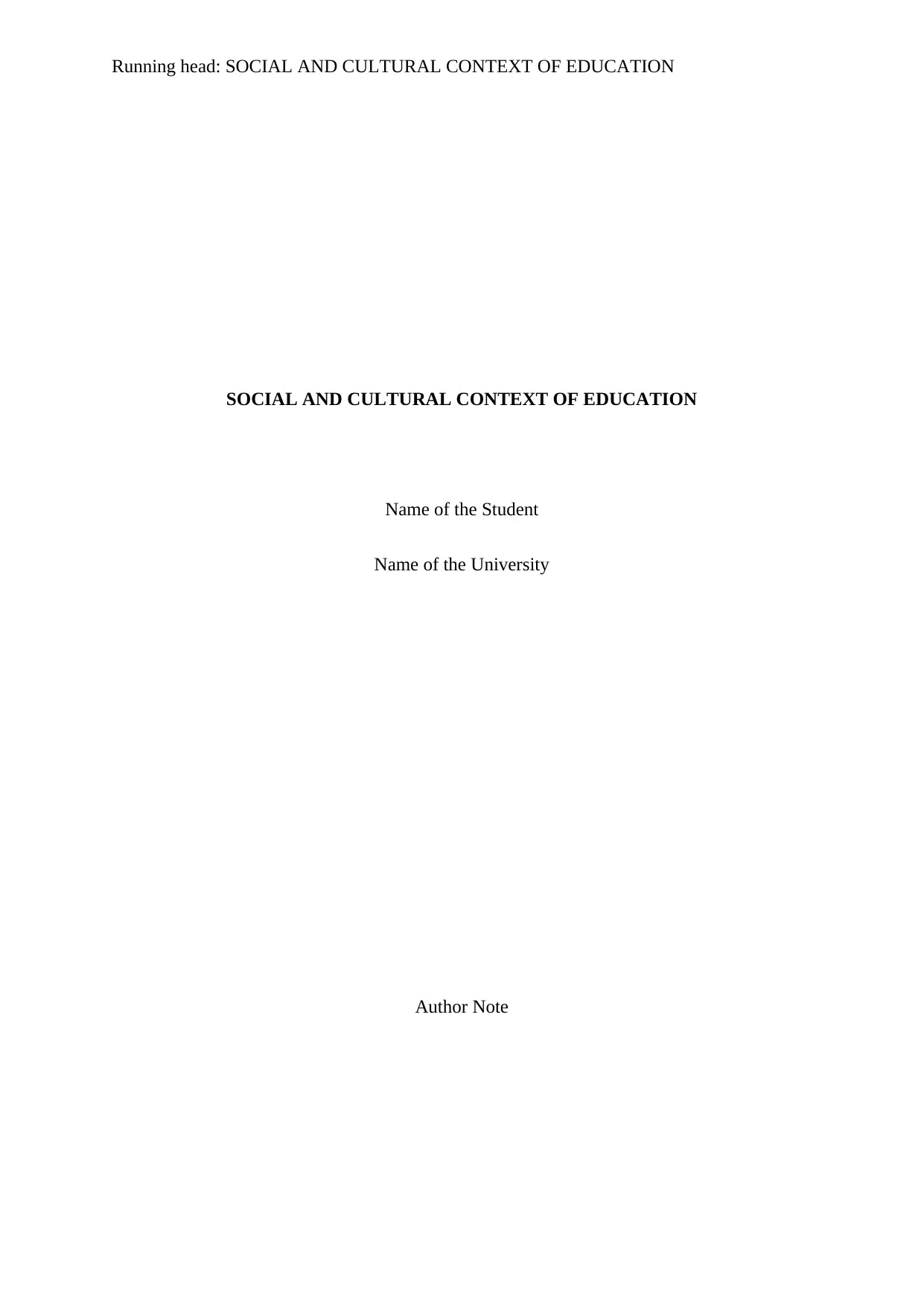
Running head: SOCIAL AND CULTURAL CONTEXT OF EDUCATION
SOCIAL AND CULTURAL CONTEXT OF EDUCATION
Name of the Student
Name of the University
Author Note
SOCIAL AND CULTURAL CONTEXT OF EDUCATION
Name of the Student
Name of the University
Author Note
Paraphrase This Document
Need a fresh take? Get an instant paraphrase of this document with our AI Paraphraser
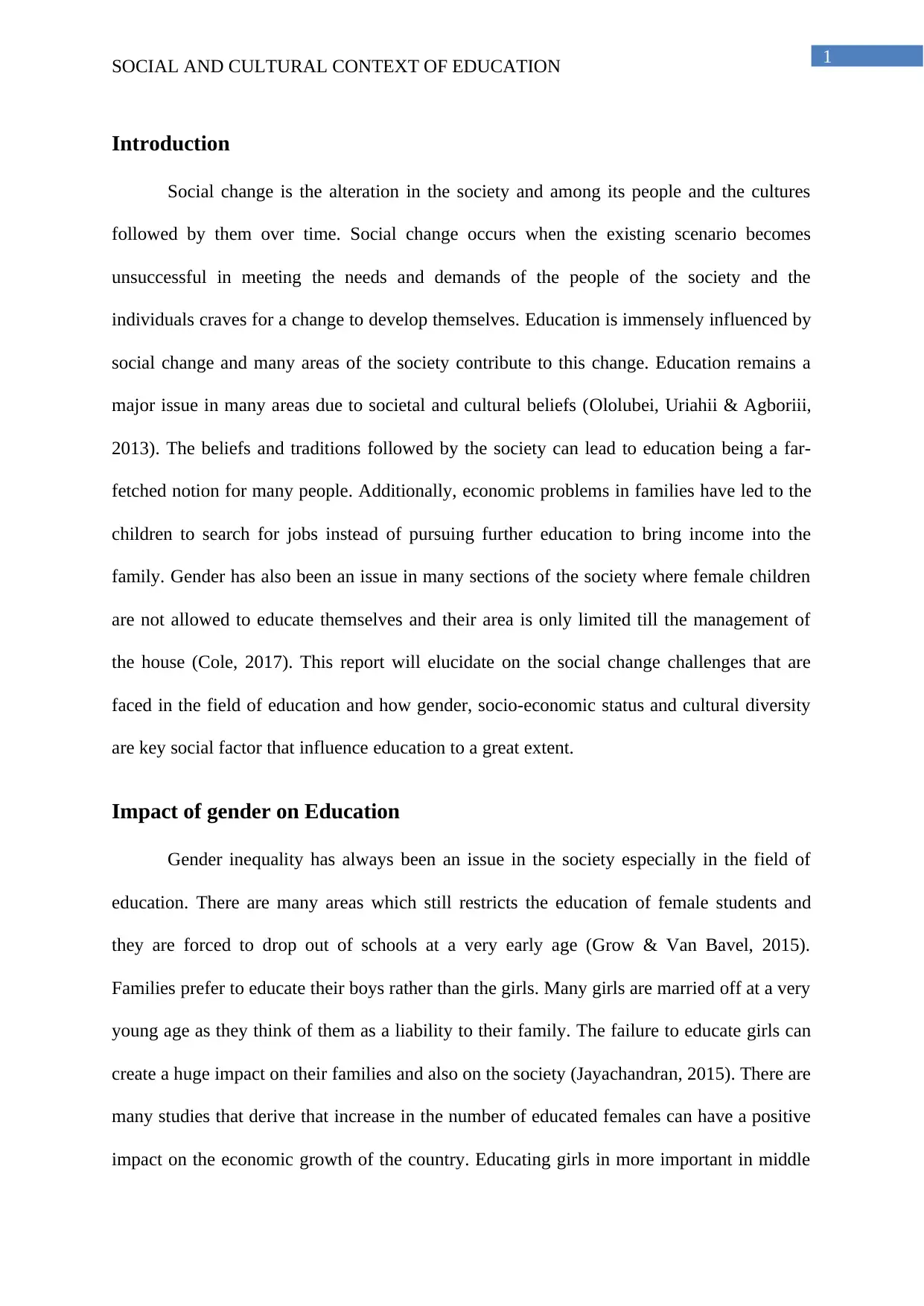
1
SOCIAL AND CULTURAL CONTEXT OF EDUCATION
Introduction
Social change is the alteration in the society and among its people and the cultures
followed by them over time. Social change occurs when the existing scenario becomes
unsuccessful in meeting the needs and demands of the people of the society and the
individuals craves for a change to develop themselves. Education is immensely influenced by
social change and many areas of the society contribute to this change. Education remains a
major issue in many areas due to societal and cultural beliefs (Ololubei, Uriahii & Agboriii,
2013). The beliefs and traditions followed by the society can lead to education being a far-
fetched notion for many people. Additionally, economic problems in families have led to the
children to search for jobs instead of pursuing further education to bring income into the
family. Gender has also been an issue in many sections of the society where female children
are not allowed to educate themselves and their area is only limited till the management of
the house (Cole, 2017). This report will elucidate on the social change challenges that are
faced in the field of education and how gender, socio-economic status and cultural diversity
are key social factor that influence education to a great extent.
Impact of gender on Education
Gender inequality has always been an issue in the society especially in the field of
education. There are many areas which still restricts the education of female students and
they are forced to drop out of schools at a very early age (Grow & Van Bavel, 2015).
Families prefer to educate their boys rather than the girls. Many girls are married off at a very
young age as they think of them as a liability to their family. The failure to educate girls can
create a huge impact on their families and also on the society (Jayachandran, 2015). There are
many studies that derive that increase in the number of educated females can have a positive
impact on the economic growth of the country. Educating girls in more important in middle
SOCIAL AND CULTURAL CONTEXT OF EDUCATION
Introduction
Social change is the alteration in the society and among its people and the cultures
followed by them over time. Social change occurs when the existing scenario becomes
unsuccessful in meeting the needs and demands of the people of the society and the
individuals craves for a change to develop themselves. Education is immensely influenced by
social change and many areas of the society contribute to this change. Education remains a
major issue in many areas due to societal and cultural beliefs (Ololubei, Uriahii & Agboriii,
2013). The beliefs and traditions followed by the society can lead to education being a far-
fetched notion for many people. Additionally, economic problems in families have led to the
children to search for jobs instead of pursuing further education to bring income into the
family. Gender has also been an issue in many sections of the society where female children
are not allowed to educate themselves and their area is only limited till the management of
the house (Cole, 2017). This report will elucidate on the social change challenges that are
faced in the field of education and how gender, socio-economic status and cultural diversity
are key social factor that influence education to a great extent.
Impact of gender on Education
Gender inequality has always been an issue in the society especially in the field of
education. There are many areas which still restricts the education of female students and
they are forced to drop out of schools at a very early age (Grow & Van Bavel, 2015).
Families prefer to educate their boys rather than the girls. Many girls are married off at a very
young age as they think of them as a liability to their family. The failure to educate girls can
create a huge impact on their families and also on the society (Jayachandran, 2015). There are
many studies that derive that increase in the number of educated females can have a positive
impact on the economic growth of the country. Educating girls in more important in middle
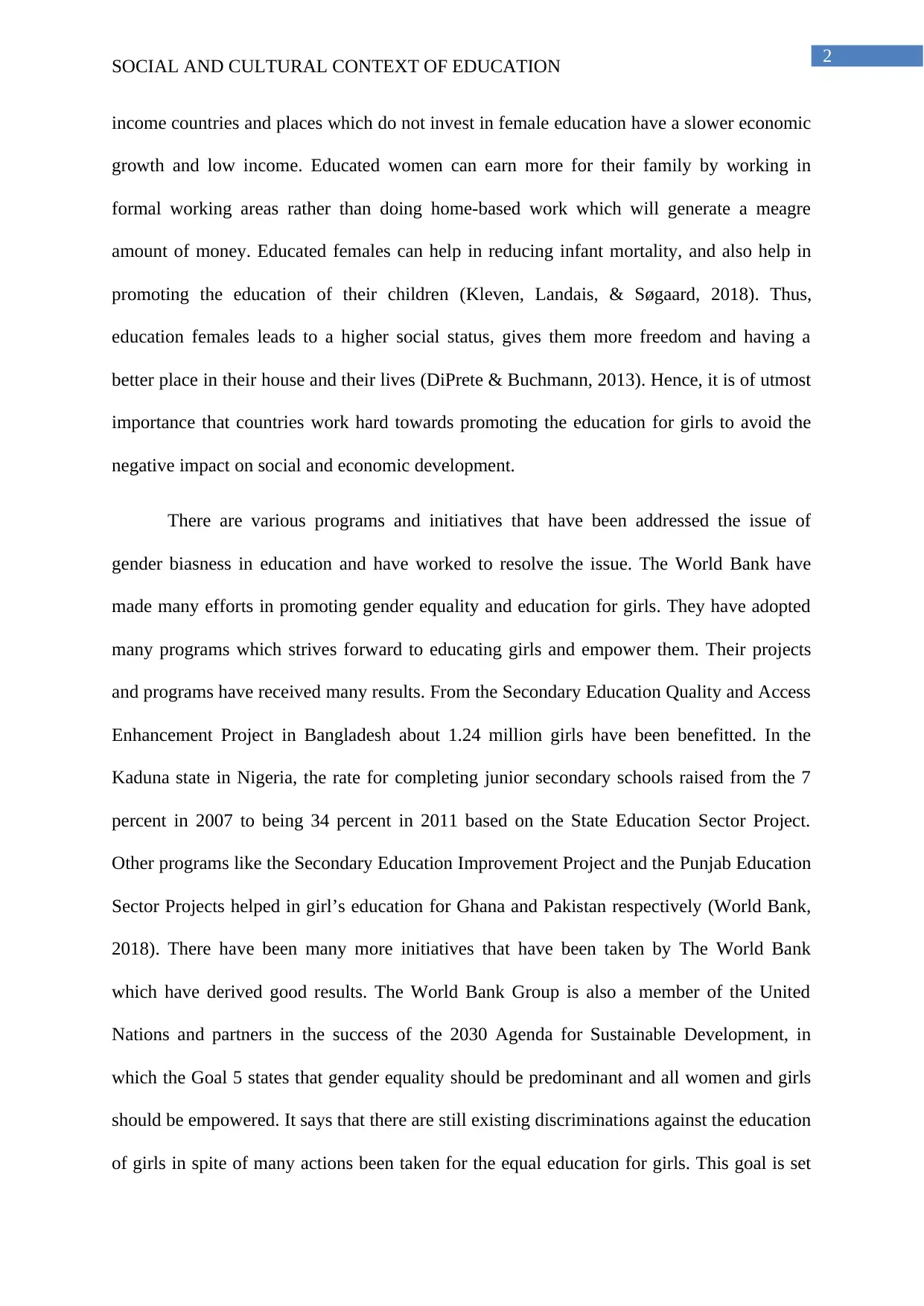
2
SOCIAL AND CULTURAL CONTEXT OF EDUCATION
income countries and places which do not invest in female education have a slower economic
growth and low income. Educated women can earn more for their family by working in
formal working areas rather than doing home-based work which will generate a meagre
amount of money. Educated females can help in reducing infant mortality, and also help in
promoting the education of their children (Kleven, Landais, & Søgaard, 2018). Thus,
education females leads to a higher social status, gives them more freedom and having a
better place in their house and their lives (DiPrete & Buchmann, 2013). Hence, it is of utmost
importance that countries work hard towards promoting the education for girls to avoid the
negative impact on social and economic development.
There are various programs and initiatives that have been addressed the issue of
gender biasness in education and have worked to resolve the issue. The World Bank have
made many efforts in promoting gender equality and education for girls. They have adopted
many programs which strives forward to educating girls and empower them. Their projects
and programs have received many results. From the Secondary Education Quality and Access
Enhancement Project in Bangladesh about 1.24 million girls have been benefitted. In the
Kaduna state in Nigeria, the rate for completing junior secondary schools raised from the 7
percent in 2007 to being 34 percent in 2011 based on the State Education Sector Project.
Other programs like the Secondary Education Improvement Project and the Punjab Education
Sector Projects helped in girl’s education for Ghana and Pakistan respectively (World Bank,
2018). There have been many more initiatives that have been taken by The World Bank
which have derived good results. The World Bank Group is also a member of the United
Nations and partners in the success of the 2030 Agenda for Sustainable Development, in
which the Goal 5 states that gender equality should be predominant and all women and girls
should be empowered. It says that there are still existing discriminations against the education
of girls in spite of many actions been taken for the equal education for girls. This goal is set
SOCIAL AND CULTURAL CONTEXT OF EDUCATION
income countries and places which do not invest in female education have a slower economic
growth and low income. Educated women can earn more for their family by working in
formal working areas rather than doing home-based work which will generate a meagre
amount of money. Educated females can help in reducing infant mortality, and also help in
promoting the education of their children (Kleven, Landais, & Søgaard, 2018). Thus,
education females leads to a higher social status, gives them more freedom and having a
better place in their house and their lives (DiPrete & Buchmann, 2013). Hence, it is of utmost
importance that countries work hard towards promoting the education for girls to avoid the
negative impact on social and economic development.
There are various programs and initiatives that have been addressed the issue of
gender biasness in education and have worked to resolve the issue. The World Bank have
made many efforts in promoting gender equality and education for girls. They have adopted
many programs which strives forward to educating girls and empower them. Their projects
and programs have received many results. From the Secondary Education Quality and Access
Enhancement Project in Bangladesh about 1.24 million girls have been benefitted. In the
Kaduna state in Nigeria, the rate for completing junior secondary schools raised from the 7
percent in 2007 to being 34 percent in 2011 based on the State Education Sector Project.
Other programs like the Secondary Education Improvement Project and the Punjab Education
Sector Projects helped in girl’s education for Ghana and Pakistan respectively (World Bank,
2018). There have been many more initiatives that have been taken by The World Bank
which have derived good results. The World Bank Group is also a member of the United
Nations and partners in the success of the 2030 Agenda for Sustainable Development, in
which the Goal 5 states that gender equality should be predominant and all women and girls
should be empowered. It says that there are still existing discriminations against the education
of girls in spite of many actions been taken for the equal education for girls. This goal is set
⊘ This is a preview!⊘
Do you want full access?
Subscribe today to unlock all pages.

Trusted by 1+ million students worldwide
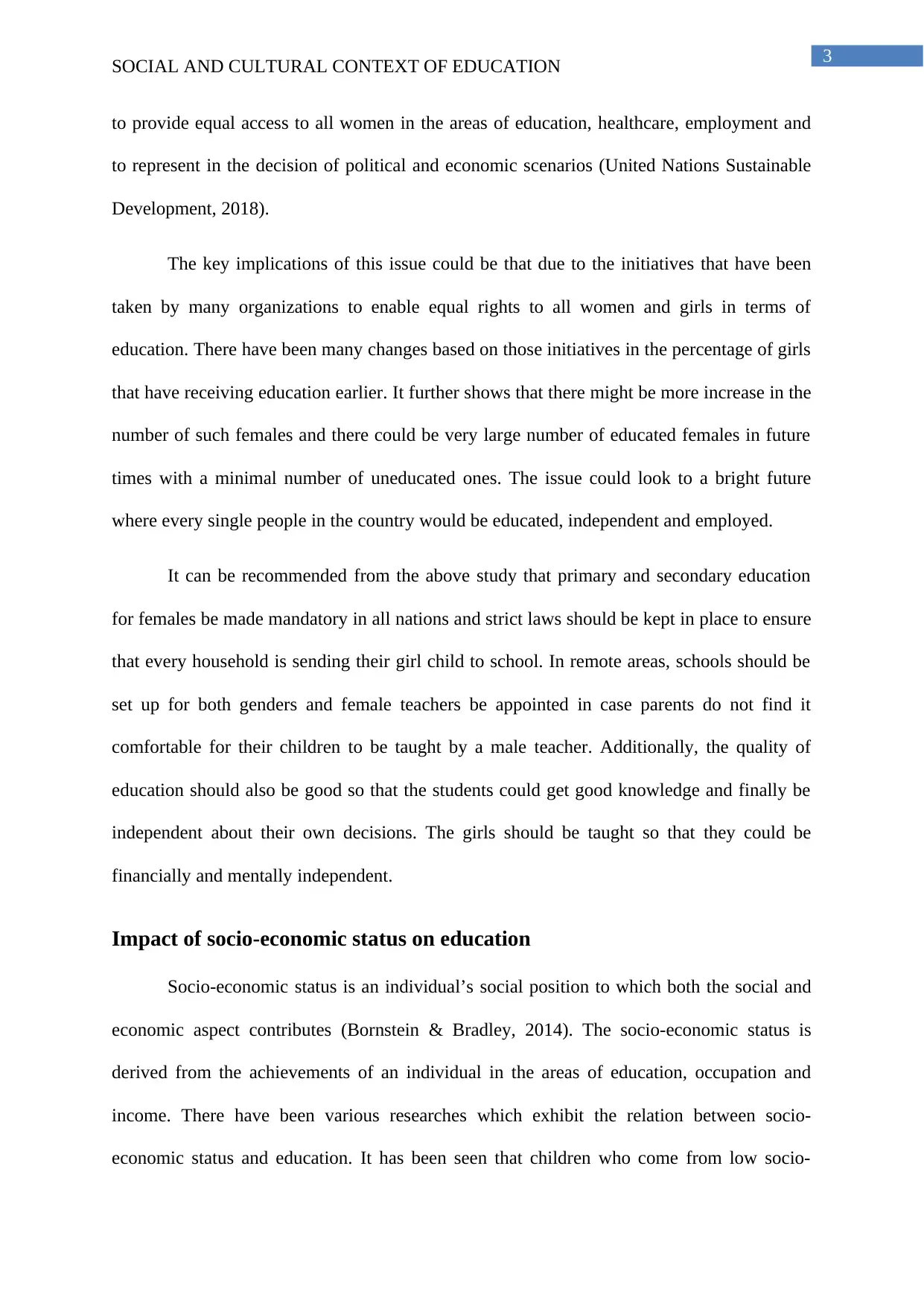
3
SOCIAL AND CULTURAL CONTEXT OF EDUCATION
to provide equal access to all women in the areas of education, healthcare, employment and
to represent in the decision of political and economic scenarios (United Nations Sustainable
Development, 2018).
The key implications of this issue could be that due to the initiatives that have been
taken by many organizations to enable equal rights to all women and girls in terms of
education. There have been many changes based on those initiatives in the percentage of girls
that have receiving education earlier. It further shows that there might be more increase in the
number of such females and there could be very large number of educated females in future
times with a minimal number of uneducated ones. The issue could look to a bright future
where every single people in the country would be educated, independent and employed.
It can be recommended from the above study that primary and secondary education
for females be made mandatory in all nations and strict laws should be kept in place to ensure
that every household is sending their girl child to school. In remote areas, schools should be
set up for both genders and female teachers be appointed in case parents do not find it
comfortable for their children to be taught by a male teacher. Additionally, the quality of
education should also be good so that the students could get good knowledge and finally be
independent about their own decisions. The girls should be taught so that they could be
financially and mentally independent.
Impact of socio-economic status on education
Socio-economic status is an individual’s social position to which both the social and
economic aspect contributes (Bornstein & Bradley, 2014). The socio-economic status is
derived from the achievements of an individual in the areas of education, occupation and
income. There have been various researches which exhibit the relation between socio-
economic status and education. It has been seen that children who come from low socio-
SOCIAL AND CULTURAL CONTEXT OF EDUCATION
to provide equal access to all women in the areas of education, healthcare, employment and
to represent in the decision of political and economic scenarios (United Nations Sustainable
Development, 2018).
The key implications of this issue could be that due to the initiatives that have been
taken by many organizations to enable equal rights to all women and girls in terms of
education. There have been many changes based on those initiatives in the percentage of girls
that have receiving education earlier. It further shows that there might be more increase in the
number of such females and there could be very large number of educated females in future
times with a minimal number of uneducated ones. The issue could look to a bright future
where every single people in the country would be educated, independent and employed.
It can be recommended from the above study that primary and secondary education
for females be made mandatory in all nations and strict laws should be kept in place to ensure
that every household is sending their girl child to school. In remote areas, schools should be
set up for both genders and female teachers be appointed in case parents do not find it
comfortable for their children to be taught by a male teacher. Additionally, the quality of
education should also be good so that the students could get good knowledge and finally be
independent about their own decisions. The girls should be taught so that they could be
financially and mentally independent.
Impact of socio-economic status on education
Socio-economic status is an individual’s social position to which both the social and
economic aspect contributes (Bornstein & Bradley, 2014). The socio-economic status is
derived from the achievements of an individual in the areas of education, occupation and
income. There have been various researches which exhibit the relation between socio-
economic status and education. It has been seen that children who come from low socio-
Paraphrase This Document
Need a fresh take? Get an instant paraphrase of this document with our AI Paraphraser
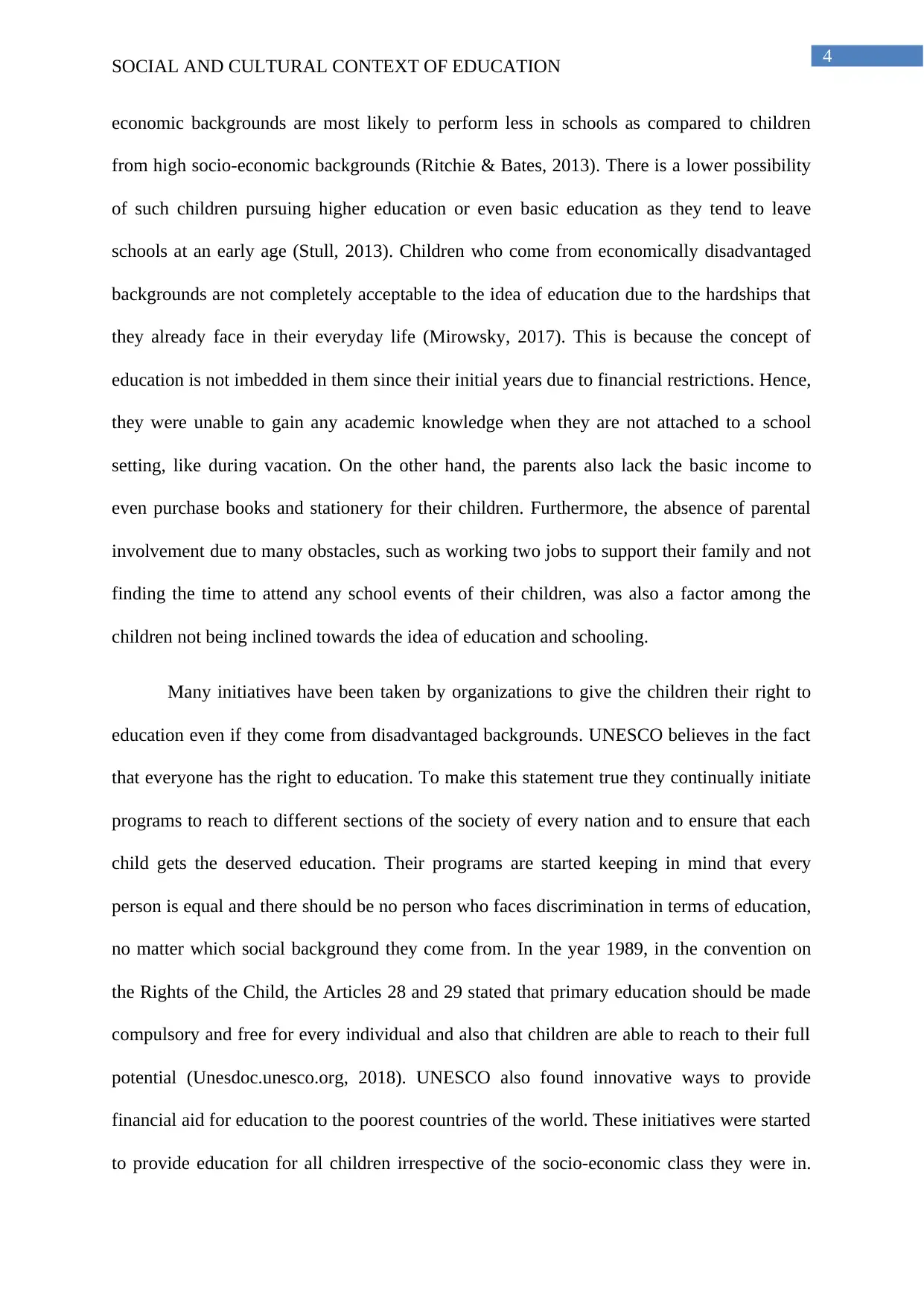
4
SOCIAL AND CULTURAL CONTEXT OF EDUCATION
economic backgrounds are most likely to perform less in schools as compared to children
from high socio-economic backgrounds (Ritchie & Bates, 2013). There is a lower possibility
of such children pursuing higher education or even basic education as they tend to leave
schools at an early age (Stull, 2013). Children who come from economically disadvantaged
backgrounds are not completely acceptable to the idea of education due to the hardships that
they already face in their everyday life (Mirowsky, 2017). This is because the concept of
education is not imbedded in them since their initial years due to financial restrictions. Hence,
they were unable to gain any academic knowledge when they are not attached to a school
setting, like during vacation. On the other hand, the parents also lack the basic income to
even purchase books and stationery for their children. Furthermore, the absence of parental
involvement due to many obstacles, such as working two jobs to support their family and not
finding the time to attend any school events of their children, was also a factor among the
children not being inclined towards the idea of education and schooling.
Many initiatives have been taken by organizations to give the children their right to
education even if they come from disadvantaged backgrounds. UNESCO believes in the fact
that everyone has the right to education. To make this statement true they continually initiate
programs to reach to different sections of the society of every nation and to ensure that each
child gets the deserved education. Their programs are started keeping in mind that every
person is equal and there should be no person who faces discrimination in terms of education,
no matter which social background they come from. In the year 1989, in the convention on
the Rights of the Child, the Articles 28 and 29 stated that primary education should be made
compulsory and free for every individual and also that children are able to reach to their full
potential (Unesdoc.unesco.org, 2018). UNESCO also found innovative ways to provide
financial aid for education to the poorest countries of the world. These initiatives were started
to provide education for all children irrespective of the socio-economic class they were in.
SOCIAL AND CULTURAL CONTEXT OF EDUCATION
economic backgrounds are most likely to perform less in schools as compared to children
from high socio-economic backgrounds (Ritchie & Bates, 2013). There is a lower possibility
of such children pursuing higher education or even basic education as they tend to leave
schools at an early age (Stull, 2013). Children who come from economically disadvantaged
backgrounds are not completely acceptable to the idea of education due to the hardships that
they already face in their everyday life (Mirowsky, 2017). This is because the concept of
education is not imbedded in them since their initial years due to financial restrictions. Hence,
they were unable to gain any academic knowledge when they are not attached to a school
setting, like during vacation. On the other hand, the parents also lack the basic income to
even purchase books and stationery for their children. Furthermore, the absence of parental
involvement due to many obstacles, such as working two jobs to support their family and not
finding the time to attend any school events of their children, was also a factor among the
children not being inclined towards the idea of education and schooling.
Many initiatives have been taken by organizations to give the children their right to
education even if they come from disadvantaged backgrounds. UNESCO believes in the fact
that everyone has the right to education. To make this statement true they continually initiate
programs to reach to different sections of the society of every nation and to ensure that each
child gets the deserved education. Their programs are started keeping in mind that every
person is equal and there should be no person who faces discrimination in terms of education,
no matter which social background they come from. In the year 1989, in the convention on
the Rights of the Child, the Articles 28 and 29 stated that primary education should be made
compulsory and free for every individual and also that children are able to reach to their full
potential (Unesdoc.unesco.org, 2018). UNESCO also found innovative ways to provide
financial aid for education to the poorest countries of the world. These initiatives were started
to provide education for all children irrespective of the socio-economic class they were in.
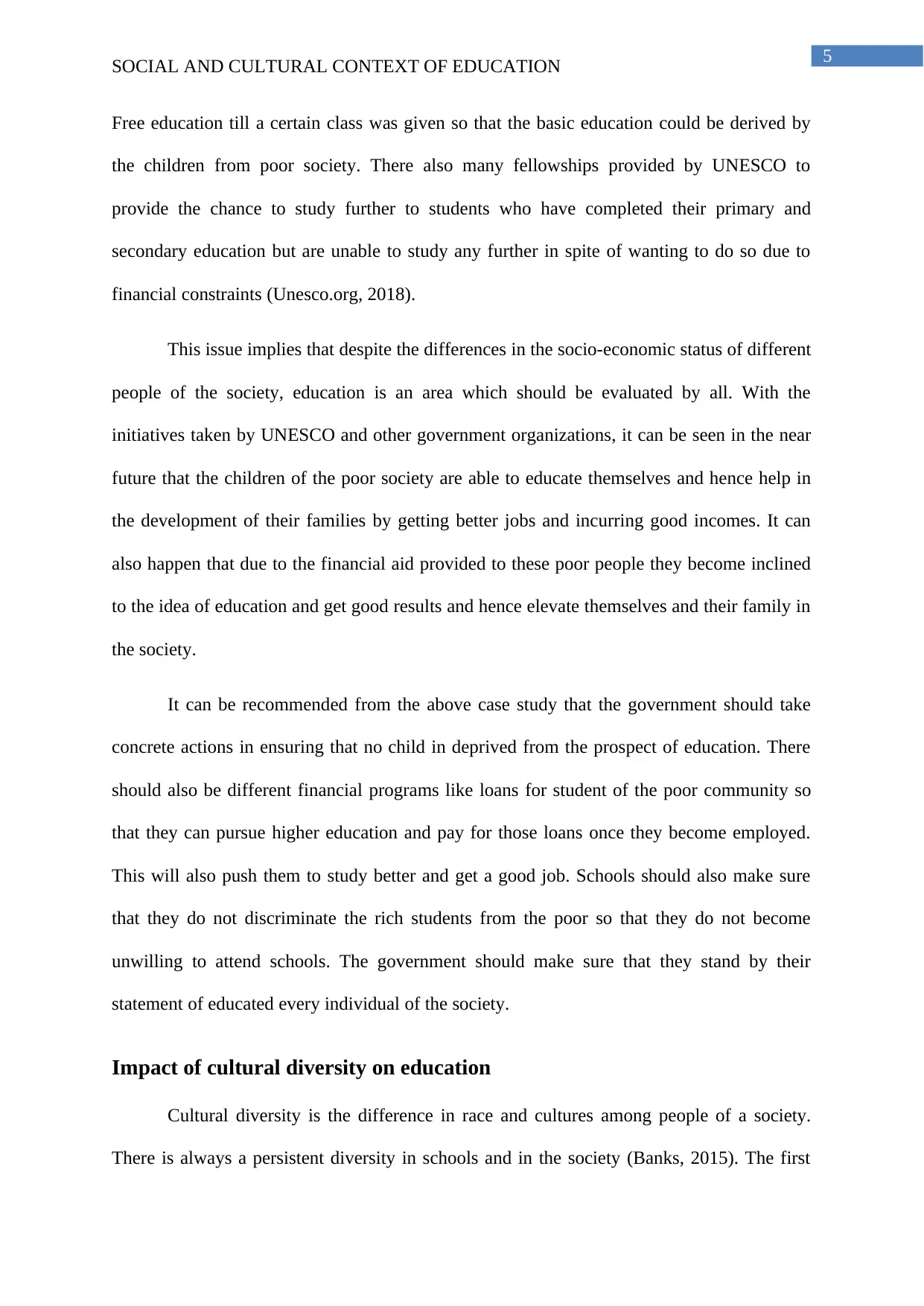
5
SOCIAL AND CULTURAL CONTEXT OF EDUCATION
Free education till a certain class was given so that the basic education could be derived by
the children from poor society. There also many fellowships provided by UNESCO to
provide the chance to study further to students who have completed their primary and
secondary education but are unable to study any further in spite of wanting to do so due to
financial constraints (Unesco.org, 2018).
This issue implies that despite the differences in the socio-economic status of different
people of the society, education is an area which should be evaluated by all. With the
initiatives taken by UNESCO and other government organizations, it can be seen in the near
future that the children of the poor society are able to educate themselves and hence help in
the development of their families by getting better jobs and incurring good incomes. It can
also happen that due to the financial aid provided to these poor people they become inclined
to the idea of education and get good results and hence elevate themselves and their family in
the society.
It can be recommended from the above case study that the government should take
concrete actions in ensuring that no child in deprived from the prospect of education. There
should also be different financial programs like loans for student of the poor community so
that they can pursue higher education and pay for those loans once they become employed.
This will also push them to study better and get a good job. Schools should also make sure
that they do not discriminate the rich students from the poor so that they do not become
unwilling to attend schools. The government should make sure that they stand by their
statement of educated every individual of the society.
Impact of cultural diversity on education
Cultural diversity is the difference in race and cultures among people of a society.
There is always a persistent diversity in schools and in the society (Banks, 2015). The first
SOCIAL AND CULTURAL CONTEXT OF EDUCATION
Free education till a certain class was given so that the basic education could be derived by
the children from poor society. There also many fellowships provided by UNESCO to
provide the chance to study further to students who have completed their primary and
secondary education but are unable to study any further in spite of wanting to do so due to
financial constraints (Unesco.org, 2018).
This issue implies that despite the differences in the socio-economic status of different
people of the society, education is an area which should be evaluated by all. With the
initiatives taken by UNESCO and other government organizations, it can be seen in the near
future that the children of the poor society are able to educate themselves and hence help in
the development of their families by getting better jobs and incurring good incomes. It can
also happen that due to the financial aid provided to these poor people they become inclined
to the idea of education and get good results and hence elevate themselves and their family in
the society.
It can be recommended from the above case study that the government should take
concrete actions in ensuring that no child in deprived from the prospect of education. There
should also be different financial programs like loans for student of the poor community so
that they can pursue higher education and pay for those loans once they become employed.
This will also push them to study better and get a good job. Schools should also make sure
that they do not discriminate the rich students from the poor so that they do not become
unwilling to attend schools. The government should make sure that they stand by their
statement of educated every individual of the society.
Impact of cultural diversity on education
Cultural diversity is the difference in race and cultures among people of a society.
There is always a persistent diversity in schools and in the society (Banks, 2015). The first
⊘ This is a preview!⊘
Do you want full access?
Subscribe today to unlock all pages.

Trusted by 1+ million students worldwide
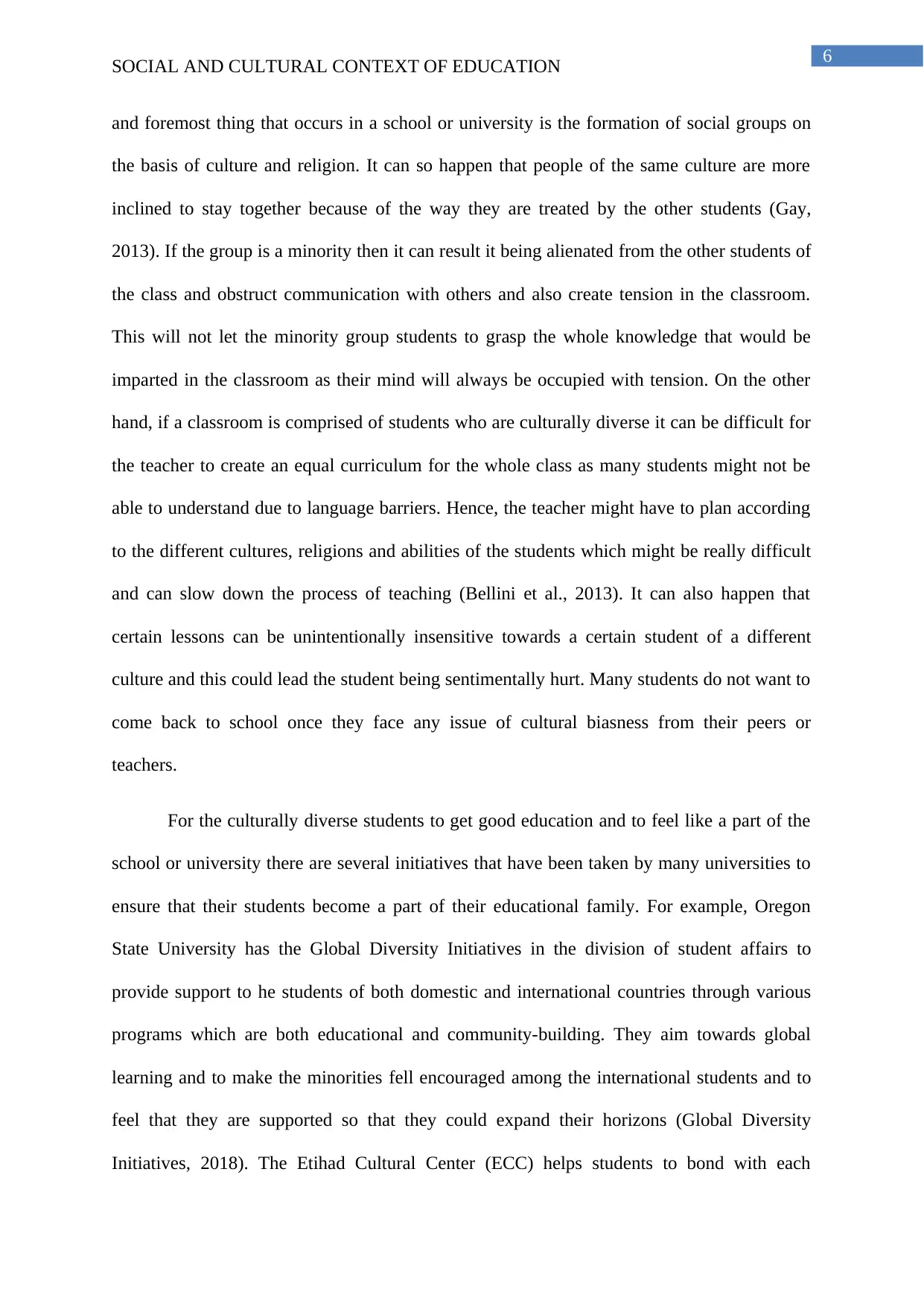
6
SOCIAL AND CULTURAL CONTEXT OF EDUCATION
and foremost thing that occurs in a school or university is the formation of social groups on
the basis of culture and religion. It can so happen that people of the same culture are more
inclined to stay together because of the way they are treated by the other students (Gay,
2013). If the group is a minority then it can result it being alienated from the other students of
the class and obstruct communication with others and also create tension in the classroom.
This will not let the minority group students to grasp the whole knowledge that would be
imparted in the classroom as their mind will always be occupied with tension. On the other
hand, if a classroom is comprised of students who are culturally diverse it can be difficult for
the teacher to create an equal curriculum for the whole class as many students might not be
able to understand due to language barriers. Hence, the teacher might have to plan according
to the different cultures, religions and abilities of the students which might be really difficult
and can slow down the process of teaching (Bellini et al., 2013). It can also happen that
certain lessons can be unintentionally insensitive towards a certain student of a different
culture and this could lead the student being sentimentally hurt. Many students do not want to
come back to school once they face any issue of cultural biasness from their peers or
teachers.
For the culturally diverse students to get good education and to feel like a part of the
school or university there are several initiatives that have been taken by many universities to
ensure that their students become a part of their educational family. For example, Oregon
State University has the Global Diversity Initiatives in the division of student affairs to
provide support to he students of both domestic and international countries through various
programs which are both educational and community-building. They aim towards global
learning and to make the minorities fell encouraged among the international students and to
feel that they are supported so that they could expand their horizons (Global Diversity
Initiatives, 2018). The Etihad Cultural Center (ECC) helps students to bond with each
SOCIAL AND CULTURAL CONTEXT OF EDUCATION
and foremost thing that occurs in a school or university is the formation of social groups on
the basis of culture and religion. It can so happen that people of the same culture are more
inclined to stay together because of the way they are treated by the other students (Gay,
2013). If the group is a minority then it can result it being alienated from the other students of
the class and obstruct communication with others and also create tension in the classroom.
This will not let the minority group students to grasp the whole knowledge that would be
imparted in the classroom as their mind will always be occupied with tension. On the other
hand, if a classroom is comprised of students who are culturally diverse it can be difficult for
the teacher to create an equal curriculum for the whole class as many students might not be
able to understand due to language barriers. Hence, the teacher might have to plan according
to the different cultures, religions and abilities of the students which might be really difficult
and can slow down the process of teaching (Bellini et al., 2013). It can also happen that
certain lessons can be unintentionally insensitive towards a certain student of a different
culture and this could lead the student being sentimentally hurt. Many students do not want to
come back to school once they face any issue of cultural biasness from their peers or
teachers.
For the culturally diverse students to get good education and to feel like a part of the
school or university there are several initiatives that have been taken by many universities to
ensure that their students become a part of their educational family. For example, Oregon
State University has the Global Diversity Initiatives in the division of student affairs to
provide support to he students of both domestic and international countries through various
programs which are both educational and community-building. They aim towards global
learning and to make the minorities fell encouraged among the international students and to
feel that they are supported so that they could expand their horizons (Global Diversity
Initiatives, 2018). The Etihad Cultural Center (ECC) helps students to bond with each
Paraphrase This Document
Need a fresh take? Get an instant paraphrase of this document with our AI Paraphraser
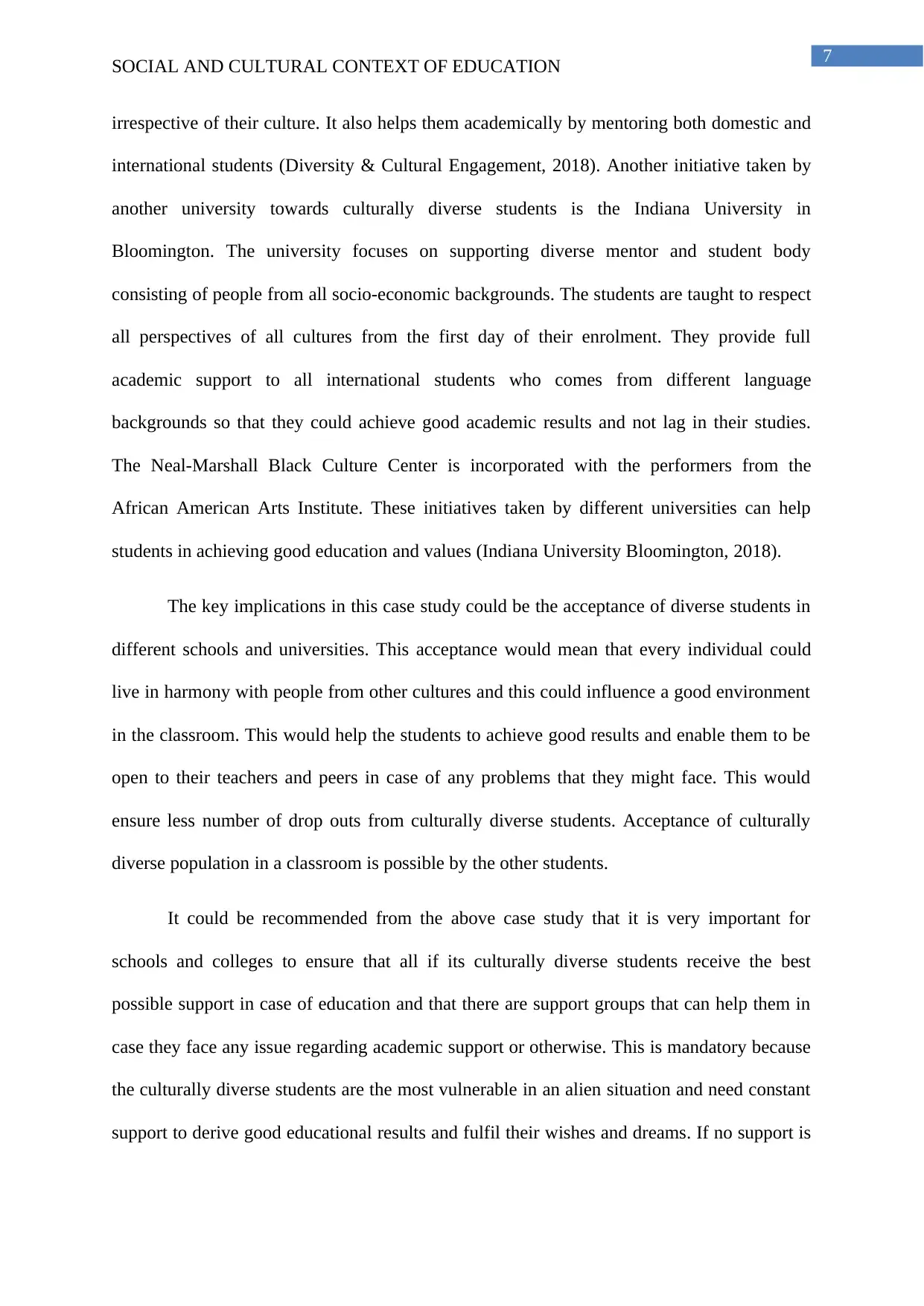
7
SOCIAL AND CULTURAL CONTEXT OF EDUCATION
irrespective of their culture. It also helps them academically by mentoring both domestic and
international students (Diversity & Cultural Engagement, 2018). Another initiative taken by
another university towards culturally diverse students is the Indiana University in
Bloomington. The university focuses on supporting diverse mentor and student body
consisting of people from all socio-economic backgrounds. The students are taught to respect
all perspectives of all cultures from the first day of their enrolment. They provide full
academic support to all international students who comes from different language
backgrounds so that they could achieve good academic results and not lag in their studies.
The Neal-Marshall Black Culture Center is incorporated with the performers from the
African American Arts Institute. These initiatives taken by different universities can help
students in achieving good education and values (Indiana University Bloomington, 2018).
The key implications in this case study could be the acceptance of diverse students in
different schools and universities. This acceptance would mean that every individual could
live in harmony with people from other cultures and this could influence a good environment
in the classroom. This would help the students to achieve good results and enable them to be
open to their teachers and peers in case of any problems that they might face. This would
ensure less number of drop outs from culturally diverse students. Acceptance of culturally
diverse population in a classroom is possible by the other students.
It could be recommended from the above case study that it is very important for
schools and colleges to ensure that all if its culturally diverse students receive the best
possible support in case of education and that there are support groups that can help them in
case they face any issue regarding academic support or otherwise. This is mandatory because
the culturally diverse students are the most vulnerable in an alien situation and need constant
support to derive good educational results and fulfil their wishes and dreams. If no support is
SOCIAL AND CULTURAL CONTEXT OF EDUCATION
irrespective of their culture. It also helps them academically by mentoring both domestic and
international students (Diversity & Cultural Engagement, 2018). Another initiative taken by
another university towards culturally diverse students is the Indiana University in
Bloomington. The university focuses on supporting diverse mentor and student body
consisting of people from all socio-economic backgrounds. The students are taught to respect
all perspectives of all cultures from the first day of their enrolment. They provide full
academic support to all international students who comes from different language
backgrounds so that they could achieve good academic results and not lag in their studies.
The Neal-Marshall Black Culture Center is incorporated with the performers from the
African American Arts Institute. These initiatives taken by different universities can help
students in achieving good education and values (Indiana University Bloomington, 2018).
The key implications in this case study could be the acceptance of diverse students in
different schools and universities. This acceptance would mean that every individual could
live in harmony with people from other cultures and this could influence a good environment
in the classroom. This would help the students to achieve good results and enable them to be
open to their teachers and peers in case of any problems that they might face. This would
ensure less number of drop outs from culturally diverse students. Acceptance of culturally
diverse population in a classroom is possible by the other students.
It could be recommended from the above case study that it is very important for
schools and colleges to ensure that all if its culturally diverse students receive the best
possible support in case of education and that there are support groups that can help them in
case they face any issue regarding academic support or otherwise. This is mandatory because
the culturally diverse students are the most vulnerable in an alien situation and need constant
support to derive good educational results and fulfil their wishes and dreams. If no support is
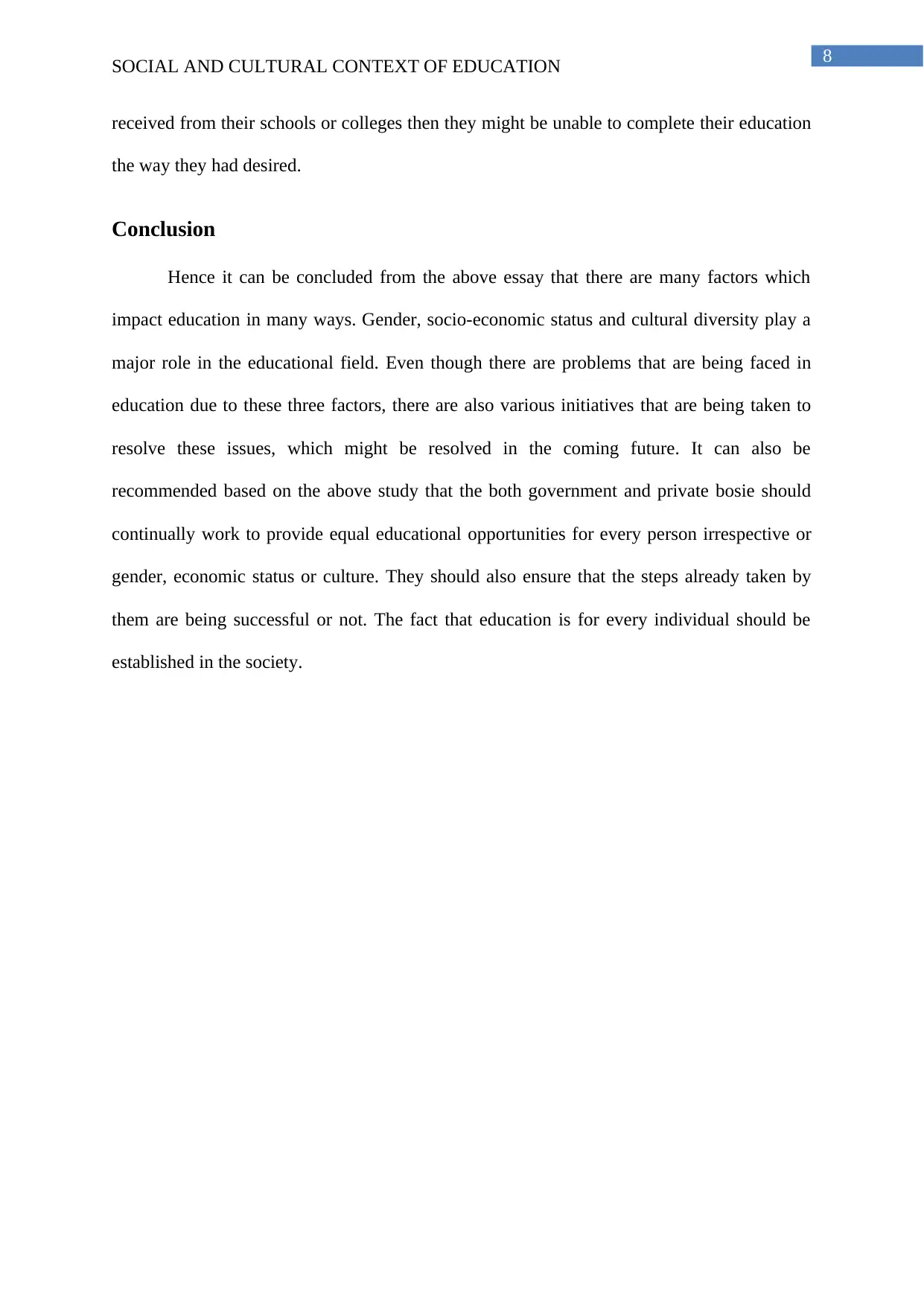
8
SOCIAL AND CULTURAL CONTEXT OF EDUCATION
received from their schools or colleges then they might be unable to complete their education
the way they had desired.
Conclusion
Hence it can be concluded from the above essay that there are many factors which
impact education in many ways. Gender, socio-economic status and cultural diversity play a
major role in the educational field. Even though there are problems that are being faced in
education due to these three factors, there are also various initiatives that are being taken to
resolve these issues, which might be resolved in the coming future. It can also be
recommended based on the above study that the both government and private bosie should
continually work to provide equal educational opportunities for every person irrespective or
gender, economic status or culture. They should also ensure that the steps already taken by
them are being successful or not. The fact that education is for every individual should be
established in the society.
SOCIAL AND CULTURAL CONTEXT OF EDUCATION
received from their schools or colleges then they might be unable to complete their education
the way they had desired.
Conclusion
Hence it can be concluded from the above essay that there are many factors which
impact education in many ways. Gender, socio-economic status and cultural diversity play a
major role in the educational field. Even though there are problems that are being faced in
education due to these three factors, there are also various initiatives that are being taken to
resolve these issues, which might be resolved in the coming future. It can also be
recommended based on the above study that the both government and private bosie should
continually work to provide equal educational opportunities for every person irrespective or
gender, economic status or culture. They should also ensure that the steps already taken by
them are being successful or not. The fact that education is for every individual should be
established in the society.
⊘ This is a preview!⊘
Do you want full access?
Subscribe today to unlock all pages.

Trusted by 1+ million students worldwide
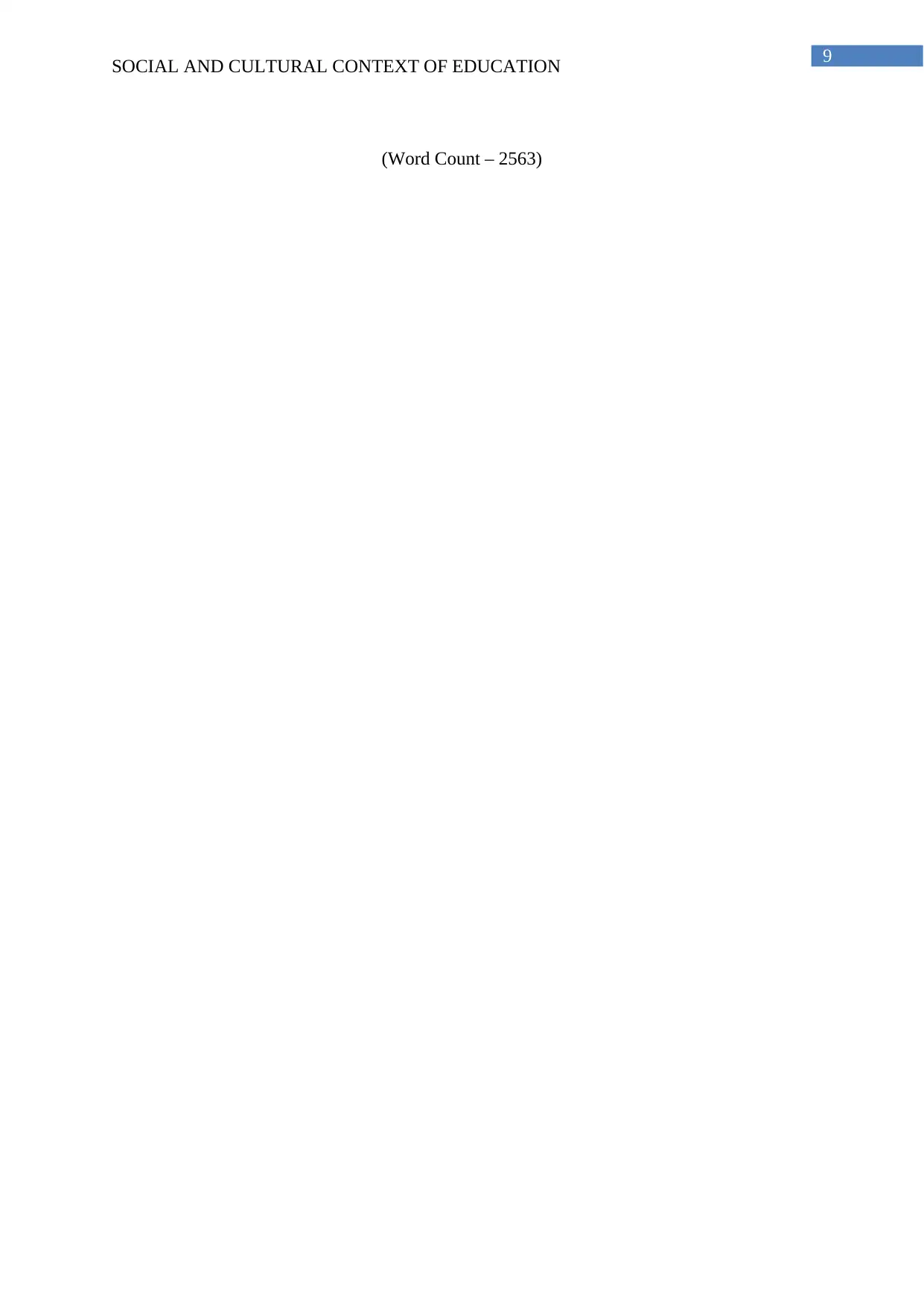
9
SOCIAL AND CULTURAL CONTEXT OF EDUCATION
(Word Count – 2563)
SOCIAL AND CULTURAL CONTEXT OF EDUCATION
(Word Count – 2563)
Paraphrase This Document
Need a fresh take? Get an instant paraphrase of this document with our AI Paraphraser
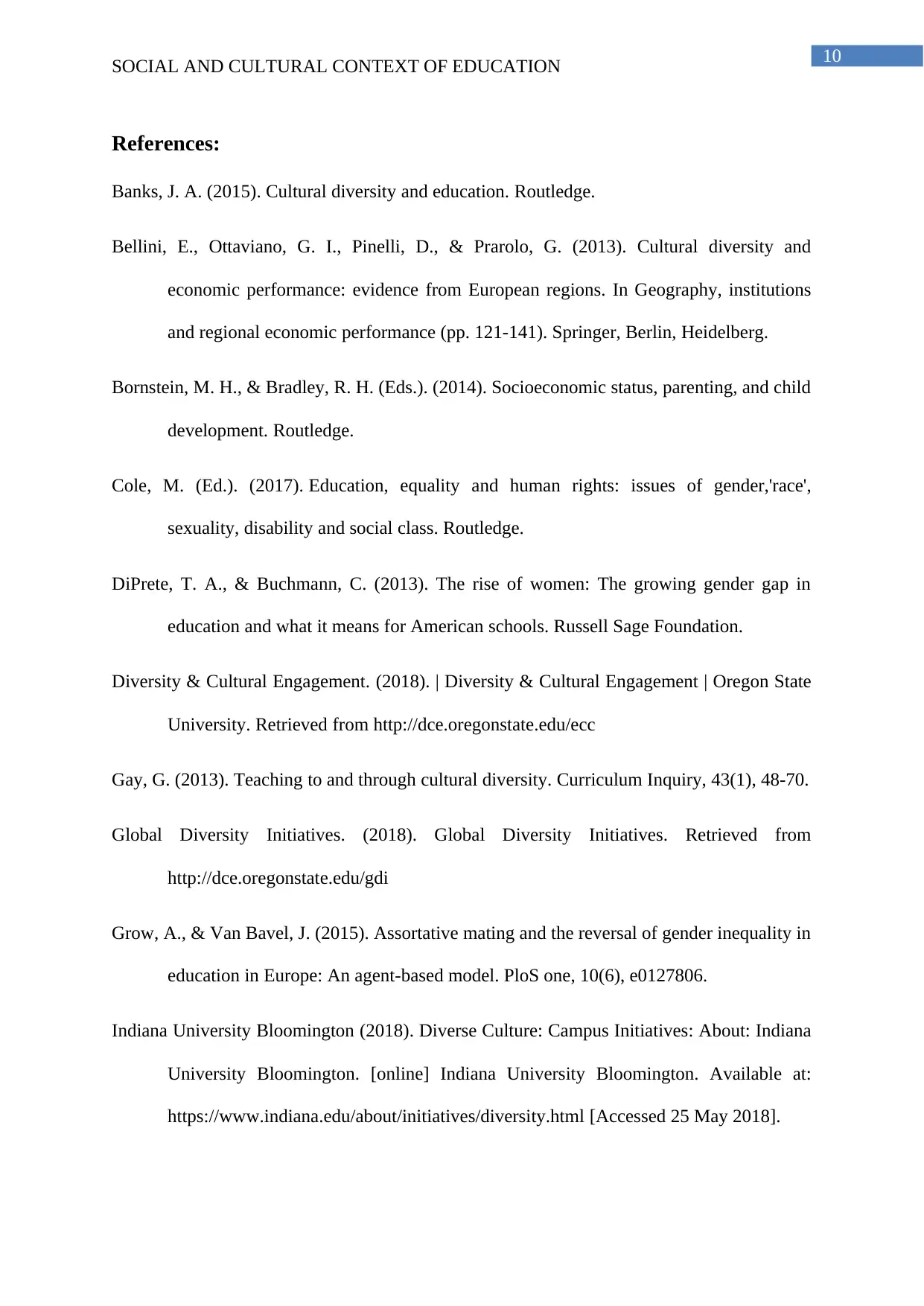
10
SOCIAL AND CULTURAL CONTEXT OF EDUCATION
References:
Banks, J. A. (2015). Cultural diversity and education. Routledge.
Bellini, E., Ottaviano, G. I., Pinelli, D., & Prarolo, G. (2013). Cultural diversity and
economic performance: evidence from European regions. In Geography, institutions
and regional economic performance (pp. 121-141). Springer, Berlin, Heidelberg.
Bornstein, M. H., & Bradley, R. H. (Eds.). (2014). Socioeconomic status, parenting, and child
development. Routledge.
Cole, M. (Ed.). (2017). Education, equality and human rights: issues of gender,'race',
sexuality, disability and social class. Routledge.
DiPrete, T. A., & Buchmann, C. (2013). The rise of women: The growing gender gap in
education and what it means for American schools. Russell Sage Foundation.
Diversity & Cultural Engagement. (2018). | Diversity & Cultural Engagement | Oregon State
University. Retrieved from http://dce.oregonstate.edu/ecc
Gay, G. (2013). Teaching to and through cultural diversity. Curriculum Inquiry, 43(1), 48-70.
Global Diversity Initiatives. (2018). Global Diversity Initiatives. Retrieved from
http://dce.oregonstate.edu/gdi
Grow, A., & Van Bavel, J. (2015). Assortative mating and the reversal of gender inequality in
education in Europe: An agent-based model. PloS one, 10(6), e0127806.
Indiana University Bloomington (2018). Diverse Culture: Campus Initiatives: About: Indiana
University Bloomington. [online] Indiana University Bloomington. Available at:
https://www.indiana.edu/about/initiatives/diversity.html [Accessed 25 May 2018].
SOCIAL AND CULTURAL CONTEXT OF EDUCATION
References:
Banks, J. A. (2015). Cultural diversity and education. Routledge.
Bellini, E., Ottaviano, G. I., Pinelli, D., & Prarolo, G. (2013). Cultural diversity and
economic performance: evidence from European regions. In Geography, institutions
and regional economic performance (pp. 121-141). Springer, Berlin, Heidelberg.
Bornstein, M. H., & Bradley, R. H. (Eds.). (2014). Socioeconomic status, parenting, and child
development. Routledge.
Cole, M. (Ed.). (2017). Education, equality and human rights: issues of gender,'race',
sexuality, disability and social class. Routledge.
DiPrete, T. A., & Buchmann, C. (2013). The rise of women: The growing gender gap in
education and what it means for American schools. Russell Sage Foundation.
Diversity & Cultural Engagement. (2018). | Diversity & Cultural Engagement | Oregon State
University. Retrieved from http://dce.oregonstate.edu/ecc
Gay, G. (2013). Teaching to and through cultural diversity. Curriculum Inquiry, 43(1), 48-70.
Global Diversity Initiatives. (2018). Global Diversity Initiatives. Retrieved from
http://dce.oregonstate.edu/gdi
Grow, A., & Van Bavel, J. (2015). Assortative mating and the reversal of gender inequality in
education in Europe: An agent-based model. PloS one, 10(6), e0127806.
Indiana University Bloomington (2018). Diverse Culture: Campus Initiatives: About: Indiana
University Bloomington. [online] Indiana University Bloomington. Available at:
https://www.indiana.edu/about/initiatives/diversity.html [Accessed 25 May 2018].
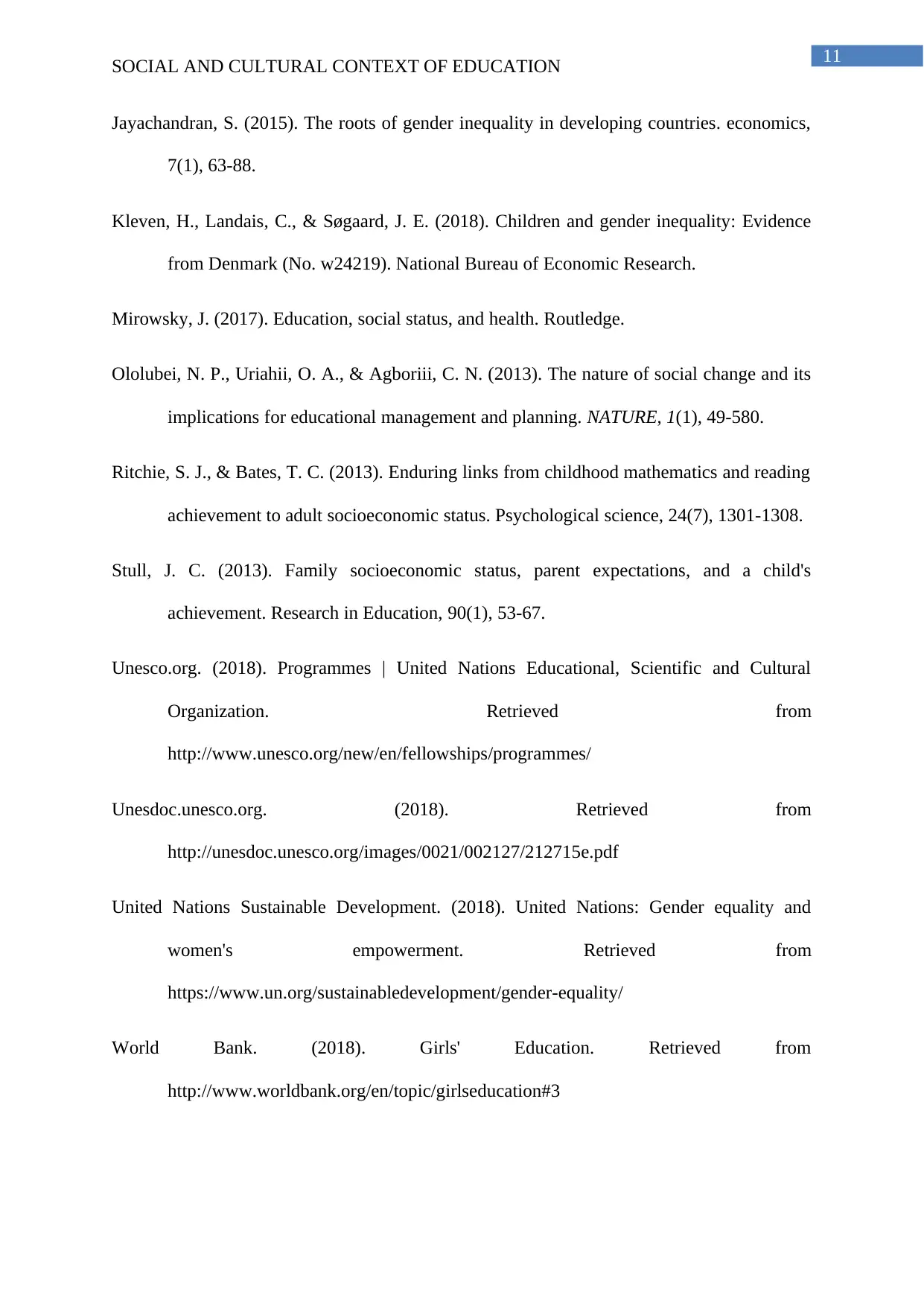
11
SOCIAL AND CULTURAL CONTEXT OF EDUCATION
Jayachandran, S. (2015). The roots of gender inequality in developing countries. economics,
7(1), 63-88.
Kleven, H., Landais, C., & Søgaard, J. E. (2018). Children and gender inequality: Evidence
from Denmark (No. w24219). National Bureau of Economic Research.
Mirowsky, J. (2017). Education, social status, and health. Routledge.
Ololubei, N. P., Uriahii, O. A., & Agboriii, C. N. (2013). The nature of social change and its
implications for educational management and planning. NATURE, 1(1), 49-580.
Ritchie, S. J., & Bates, T. C. (2013). Enduring links from childhood mathematics and reading
achievement to adult socioeconomic status. Psychological science, 24(7), 1301-1308.
Stull, J. C. (2013). Family socioeconomic status, parent expectations, and a child's
achievement. Research in Education, 90(1), 53-67.
Unesco.org. (2018). Programmes | United Nations Educational, Scientific and Cultural
Organization. Retrieved from
http://www.unesco.org/new/en/fellowships/programmes/
Unesdoc.unesco.org. (2018). Retrieved from
http://unesdoc.unesco.org/images/0021/002127/212715e.pdf
United Nations Sustainable Development. (2018). United Nations: Gender equality and
women's empowerment. Retrieved from
https://www.un.org/sustainabledevelopment/gender-equality/
World Bank. (2018). Girls' Education. Retrieved from
http://www.worldbank.org/en/topic/girlseducation#3
SOCIAL AND CULTURAL CONTEXT OF EDUCATION
Jayachandran, S. (2015). The roots of gender inequality in developing countries. economics,
7(1), 63-88.
Kleven, H., Landais, C., & Søgaard, J. E. (2018). Children and gender inequality: Evidence
from Denmark (No. w24219). National Bureau of Economic Research.
Mirowsky, J. (2017). Education, social status, and health. Routledge.
Ololubei, N. P., Uriahii, O. A., & Agboriii, C. N. (2013). The nature of social change and its
implications for educational management and planning. NATURE, 1(1), 49-580.
Ritchie, S. J., & Bates, T. C. (2013). Enduring links from childhood mathematics and reading
achievement to adult socioeconomic status. Psychological science, 24(7), 1301-1308.
Stull, J. C. (2013). Family socioeconomic status, parent expectations, and a child's
achievement. Research in Education, 90(1), 53-67.
Unesco.org. (2018). Programmes | United Nations Educational, Scientific and Cultural
Organization. Retrieved from
http://www.unesco.org/new/en/fellowships/programmes/
Unesdoc.unesco.org. (2018). Retrieved from
http://unesdoc.unesco.org/images/0021/002127/212715e.pdf
United Nations Sustainable Development. (2018). United Nations: Gender equality and
women's empowerment. Retrieved from
https://www.un.org/sustainabledevelopment/gender-equality/
World Bank. (2018). Girls' Education. Retrieved from
http://www.worldbank.org/en/topic/girlseducation#3
⊘ This is a preview!⊘
Do you want full access?
Subscribe today to unlock all pages.

Trusted by 1+ million students worldwide
1 out of 12
Related Documents
Your All-in-One AI-Powered Toolkit for Academic Success.
+13062052269
info@desklib.com
Available 24*7 on WhatsApp / Email
![[object Object]](/_next/static/media/star-bottom.7253800d.svg)
Unlock your academic potential
Copyright © 2020–2025 A2Z Services. All Rights Reserved. Developed and managed by ZUCOL.





